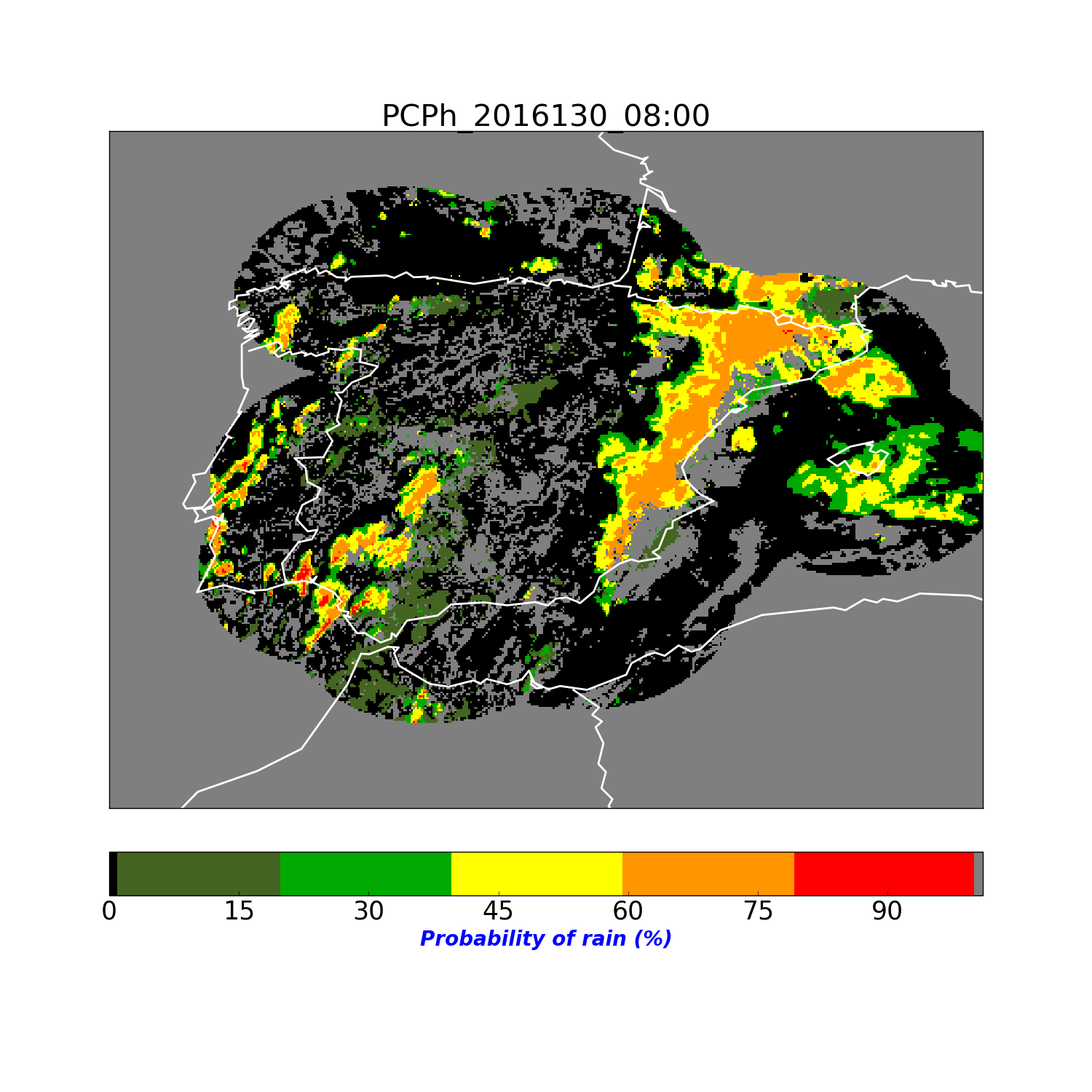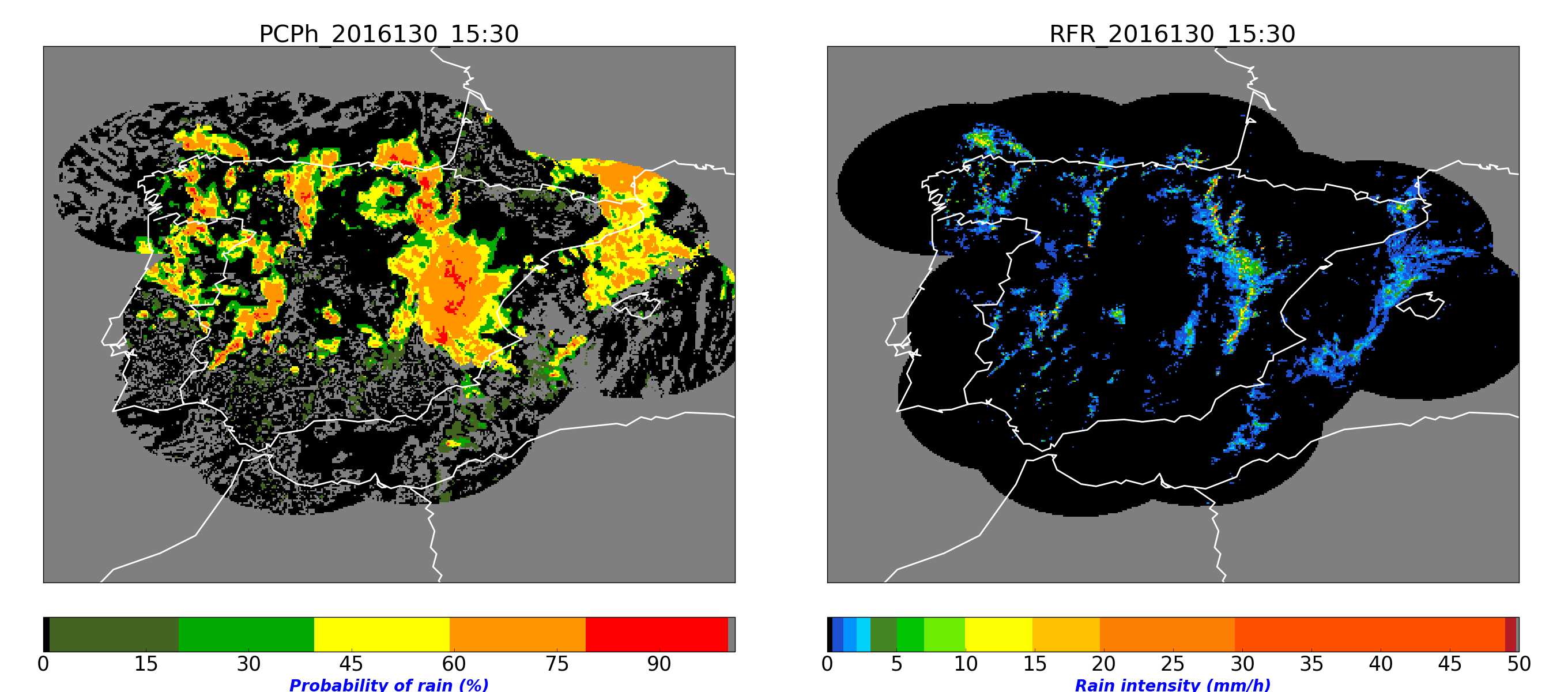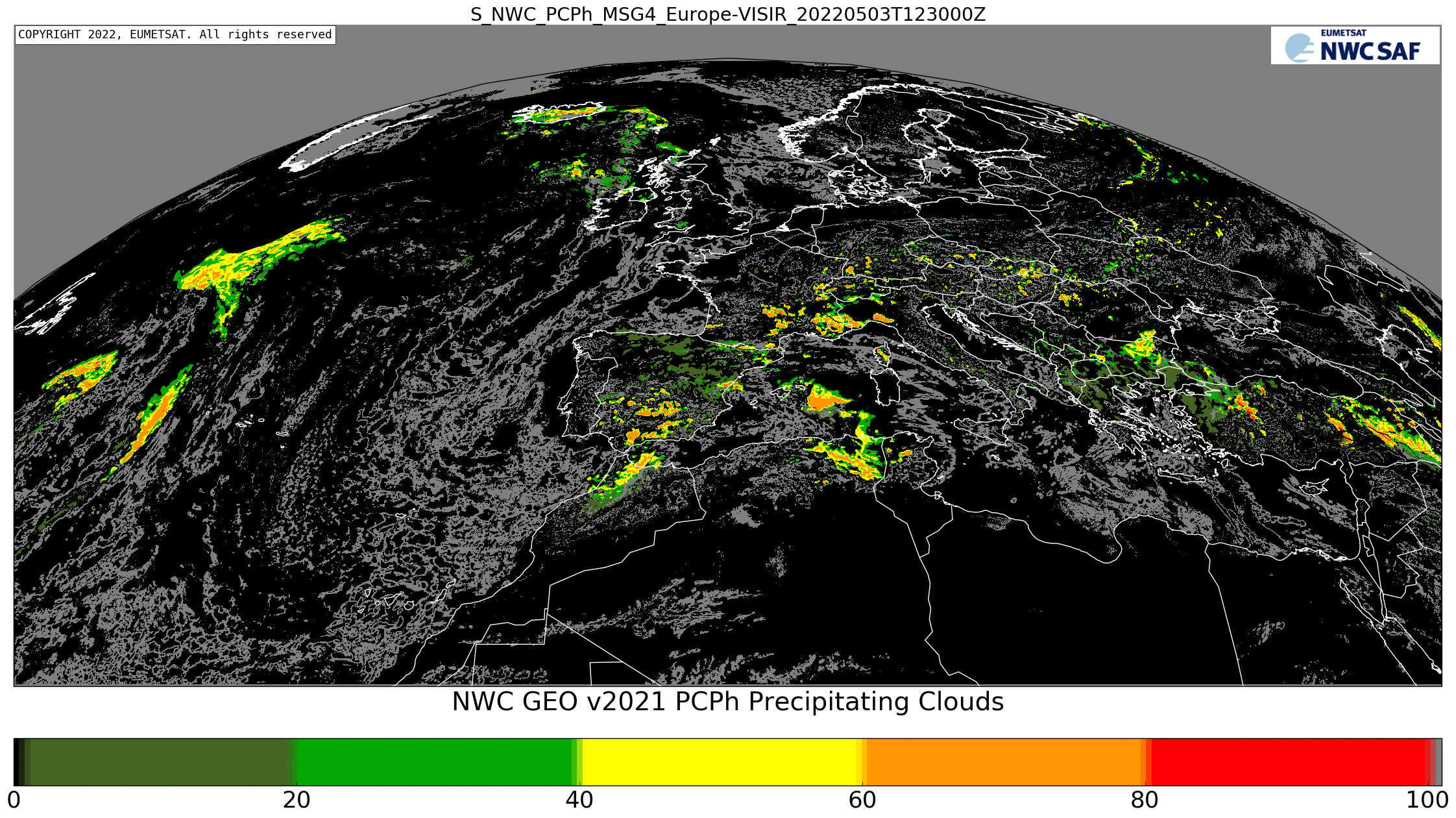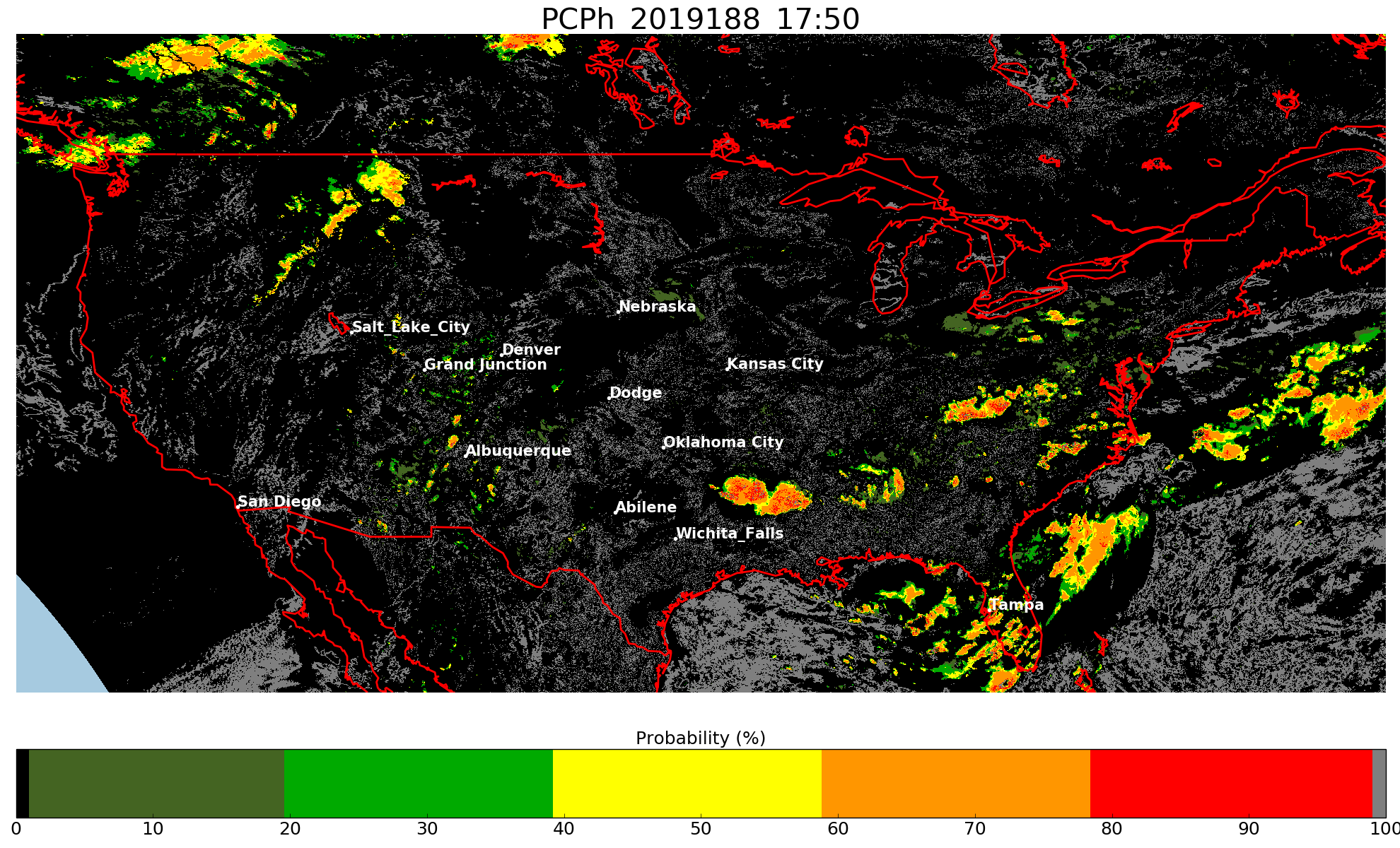
Precipitating Clouds from Cloud Physical Properties
(NWC/GEO PCPh,v2021)
Table of contents
1. Goal of PCPh product
2. PCPh algorithm description
3. PCPh correction factors
4. List of inputs for PCPh
5. Description of PCPh outputs
6. Example of PCPh visualisation
7. Coverage
Access to "Algorithm Theoretical Basis Document for the Precipitation Product Processors of the NWC/GEO" for a more detailed description of the algorithm.
Precipitating Clouds from cloud physical properties, developed within the NWC SAF context, is a Nowcasting tool that provides estimation on the probability of precipitation (PoP) occurrence.
2. PCPh algorithm description
Day time
PCPh v2021 is based on a Principal Component Analisis (PCA). PoP estimations are done collecting information from the Cloud Phase, the Effective Radius (Reff) and the Cloud Optical Thickness (COT). All these three parameters are part of the CMIC retrieval. Based on COT and Reff, the Cloud Water is computed (CWP = 2/3 COT * REFF). The Cloud Phase is available during the whole day whereas Reff and COT are only available at day time. Along with the microphysical information, SEVIRI channels are also used: five infrared channels (IR8.7,IR9.7,IR108,IR120,IR134), one visible channel (VIS0.6) that has been normalized and corrected with the sun-earth distance and two water vapour channels (WV6.2,WV7.3)
PCPh has been calibrated in boxes size of 25*25 pixels centred in radar pixels with rain rates > 0.2 mm/h. By using PCA’s satellite information has been compressed in two principal components that keep the 95% of the whole variance.
For a better probability of precipitation area location a parallax correction can be applied to this product. This option is chosen by the user through the product model configuration file and it is applied by default.
Night time
One single algorithm is used for the whole day. That means the same inputs used at day time are required at night time. Since CWP and the VIS0.6 channel are only available at day time, an artificial method has been developed to create a pseudo-CWP and a pseudo-VIS06 derived from infrared and water vapour channels, also based on a principal component analysis.
Transition between day to night algorithm is produced whenever the solar zenith angle is greater than 70º. It is also possible to configure the product to only use the night algorithm by setting the sun zenith angle threshold to 0. This would avoid discontinuities in the product at the day/night transition on the cost of degrading performance during day time.
3.PCPh correction factors:
Stability correction:
Like other NWC SAF products do, such as the RDT-CI (Rapidly Developing Thunderstorm – Convection Warning) a stability mask is used. This mask make use of the NWP data to compute several convective indexes: K Index (KI), Showalter (SHW) and Lifted Index (LI). The combination of such indexes allow to identify stable regions where convection is unlikely to happen.
If pixel value of LI index stable (>0) and pixel value of SHW index stable (>3) and pixel value of KI index stable (< 20), then it will considered full stable case at pixel level.
Precipitation output for PCPh and CRRPh is removed in those stable regions. This stable mask is an optional parameter and configurable by the user. It is set to use it by default. Stability correction is used to remove PCPh output from areas where it is not likely to have rain based on NWP models, because those regions are considered stable. If a black whole inside a precipitating area appears, this effect may be directly attributed to this correction. Another known issue related to this correction is that the orography may produce some unrealistic shapes. These artefacts produced by mountains are steady and it appears in the same places so it can be easily detected.
The more accurate the model is, the more precision excluding those precipitating areas in the CRRPh basic output.
4. List of inputs for PCPh
Satellite imagery
- IR8.7, IR9.7, IR10.8,IR12.0,IR13.4 (Brightness temperature)
- VIS0.6 (Normalized reflectance and corrected with Sun distance)
- WV6.2,WV7.3 (Brightness temperature)
IR10.8 SEVIRI brightness temperature at full IR spatial resolution is a mandatory input to compute Parallax Correction.
GEO-cloud microphysics (CMIC Cloud Optical Thickness, CMIC Effective Radius, CMIC Phase)
- CMIC Phase, Cloud Optical Thickness (COT) and Effective Radius (Reff) parameters are mandatory inputs to PCPh day algorithm.
- CMIC Phase is mandatory input to compute the PCPh night algorithm.
Inputs pre-checking:
PCPh is set to zero in the following cases:
- CMIC Phase output indicates cloud free.
- CWP < 250 gm-2 for both day and night time.
- VIS0.6 normalized reflectivity < 30 for both day and night.
Cloud Water Path threshold to depict probability of precipitation areas has been empirically obtained.
Numerical model
Temperature at 1000, 925, 850, 700, 500, 400, 300, 250 and 200 hPa
Geopotential at 1000, 925, 850, 700, 500, 400, 300, 250 and 200 hPa
This information is used by default for parallax correction. In case of lack of NWP parameters parallax correction will be run using a climatological profile.
Ancillary data sets
Climatological profile is necessary as a back up for Parallax correction in case NWP is not available. This information is included in the software package.
Model configuration file for PCPh
PCPh model configuration file contains configurable system parameters in the generation process of PCPh product. The PCPh product related parameters refers to ancillary datasets, numerical model data, parallax correction and stability correction. The complete list of these parameters and the explanation of the most useful ones are available in the"User Manual for the Precipitation Product Processors of the NWC/GEO".
5. Description of PCPh outputs
PCPh product is coded in NetCDF format. The available outputs are the following:
pcph
pcph output contains the PoP associated to clouds. Probability of rain ranges from 0 to 100%.
| DAY ALGORITHM | |||
| GEO-CMIC-INPUT PHASE | PHASE INPUT CLASS | COT OR REFF FROM CMIC | PCPH OUTPUT |
| Liquid | 1 | NO DATA | NO DATA |
| DATA AVAILABLE | pcph(%) = scale_factor * counts + add_offset | ||
| Ice | 2 | NO DATA | NO DATA |
| DATA AVAILABLE | pcph(%) = scale_factor * counts + add_offset | ||
| Mixed | 3 | NO DATA | NO DATA |
| DATA AVAILABLE | pcph(%) = scale_factor * counts + add_offset | ||
| Cloud-free | 4 | NOT APPLICABLE | 0 |
| Undefined | 5 | NOT APPLICABLE | NO DATA |
| No data or corrupted data | FillValue | NOT APPLICABLE | NO DATA |
| NIGHT ALGORITHM | ||
| GEO-CMIC-INPUT PHASE | PHASE INPUT CLASS | CRRPH OUTPUT |
| Liquid | 1 | pcph(%) = scale_factor * counts + add_offset |
| Ice | 2 | pcph(%) = scale_factor * counts + add_offset |
| Mixed | 3 | pcph(%) = scale_factor * counts + add_offset |
| Cloud-free | 4 | 0 |
| Undefined | 5 | NO DATA |
| No data or corrupted data | FillValue | NO DATA |
where:
scale_factor = 1.0
add_offset = 0.0
pcph_status_flag
pcph_status_flag provides information on whether parallax correction or stability correction have been applied, the inputs used to compute the product and some other aspects:
Data Availability:
Bit 0: Reff or COT not computed (out of cloud, night time, phase not defined)
Bit 1: Phase not computed or undefined
Bit 2: IR band missing (used in parallax correction)
Applied Correction:
Bit 3: Parallax correction applied
Bit 4: Stability correction applied
Other information
Bit 8: pcph was a hole because of the parallax correction, and then was filled by the median filter
6. Example of PCPh visualisation
PCPh probability of rain
Below are shown different images of the PCPh product, day and night algorithms. It has been obtained at full resolution.

Figure 1: Comparison of PCPh day product (left side) and the Spanish radar (right side) the 9th May 2016 at 15:30UTC

Figure 2: PoP the 03th May 2022 at 12:30 UTC over Europe, day algorithm
7. Coverage
PoP can be processed by the following satellites: MSG, GOES-16 or HIMAWARI-8.
An example of visualization over USA is shown below. It has been obtained at full resolution.

Figure 3: PCPh product on 7th July 2019 at 17:50 UTC over USA, night algorithm.
References
- Pilewskie, P. and Twomey, S., 1987. Discrimination of ice from water in clouds by optical remote sensing. Atmos. Res., 21:113-122
- Rosenfeld, D., and G. Gutman, 1994. Retrieving microphysical properties near the tops of potential rain clouds by multispectral analysis of AVHRR data, Atmos. Res., 34, 259–283, doi:10.1016/0169-8095(94)90096-5.
- Roebeling, R.A., A.J. Feijt and P. Stammes, Cloud property retrievals for climate monitoring: implications of differences between SEVIRI on METEOSAT-8 and AVHRR on NOAA-17 J. Geophys. Res., 2006, 111, 20210, doi:10.1029/2005JD006990.
- Roebeling, R.A. and I. Holleman, 2009. SEVIRI rainfall retrieval and validation using weather radar observations. J. Geophys. Res., D2120, 114.
- Tapia, A., Smith, J. A., Dixon, M., 1998: Estimation of Convective Rainfall from Lightning Observations, Bull. American Meteorological Society, Vol. 37, pp. 1497-1509.
- Vicente, G.A., Scofield, R.A. and Menzel W.P. 1998: The Operational GOES Infrared Rainfall
Estimation Technique, Bull. American Meteorological Society, Vol. 79, No. 9, pp. 1883-1898. - Daniel Rosenfeld, William L. Woodley, Amit Lerner, Guy Kelman, Daniel T. Lindsey, 2008. Satellite detection of severe convective storms by their retrieved vertical profiles of cloud particle effective radius and thermodynamic phase. J. Geophys. Res. D4, 113.
- Gutierrez, J. M. and Aguado, F.: Quality image for the Spanish Radar National Composite, Proceedings of ERAD 2006, 318-320.
- Judith A. Curry Christopher D. Ardeel Lin Tian: Liquid water content and precipitation characteristics of stratiform clouds as inferred from satellite microwave measurements. Journal of Geophysical Research: Atmospheres, Volume 95, Issue D10, pp. 16,659-16,671 DOI: 10.1029/JD095iD10p16659.
- Nauss, T. and Kokhanovsky, A. A., 2007: Advances in GeosciencesAssignment of rainfall confidence values using multispectral satellite data at mid-latitudes: first results, Advances in Geosciences, 10, 99–102.
- Algorithm Theoretical Basis Document for "Precipitation products from Cloud Physical Properties" (NWC-CDOP3-GEO-AEMET-SCI-ATBDPrecipitation_v1.0.1), v2021
- Product User Manual for "Precipitation products from Cloud Physical Properties" ( NWC-CDOP3-GEO-AEMET-SCI-UM-Precipitation_v2.0.1 ), v2021
- Validation Report for "Precipitation products from Cloud Physical Properties" (PCPh v2.0 & CRRPh v2.0), v2021
